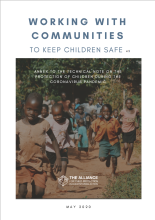
COVID-19 Technical Annexes
These annexes to the Technical Note on the Protection of Children during the COVID-19 Pandemic offer detailed guidance on key thematic areas of child protection in humanitarian action. These resources provide technical guidance and practical tools to address the unique challenges children face during infectious disease outbreaks.

In Weighing up the risks: School closure and reopening under COVID-19 — When, Why, and What Impacts?, the Alliance and INEE have developed a balanced analysis to inform decisions based on holistic child-wellbeing as to when and why to re-open schools. This paper is meant to help decision makers...

In April 2020, the Alliance COVID-19 Mapping Team began tracking resources and articles on some of the key CPMS Standards and topics around child protection and COVID-19. Almost two years later, this process has produced the Child Protection and COVID-19 Resource Tracker, which contains the final...

Experience from previous infectious disease outbreaks indicates that new child protection risks are likely to emerge from the direct effects of COVID-19 as well as from measures to prevent and control its spread. Moreover, existing child protection risks are likely to be exacerbated. Some groups of...

Emergency responses to COVID-19 are intended to speed containment of the virus but can have devastating consequences for children if they ignore unique risks to their safety and fail to include specific child protection provisions. Protecting children from violence and exploitation can be life...

Evidence from previous infectious disease outbreaks indicate that existing child protection risks are exacerbated, and new ones emerge, as a result of the epidemic as well as of the socioeconomic impacts of prevention and control measures. Some children are at increased risk in these circumstances...

A well-supported, appropriately equipped, empowered, and protected social service workforce is essential to mitigating the damaging effects of the COVID-19 pandemic. Social service workers can build on their existing strong ties to children, families, and communities to rapidly respond in ways that...

It is abundantly clear that risk factors for violence, abuse, and neglect are on the rise for children under containment. At the same time, some COVID-19 prevention measures have abruptly cut children off from positive and supportive relationships they rely on when in distress, including at school...

Worldwide, an estimated 152 million children are in child labour, almost half of them, 73 million, work in hazardous child labour. The global health crisis is leading to mass disruption with far-reaching consequences. Many children are out of school and economic pressures on families continue to...

Infectious diseases like COVID-19 can disrupt the protective environments in which children grow and develop. Disruptions to families, friendships, daily routines and the wider community can have negative consequences for children’s well-being, development and protection. COVID-19 also has a direct...

Every day a child remains with an armed force or group, he or she is at risk of physical, psychological and sexual violence, and even death. Prevention of recruitment; separating children from armed forces and groups; responding to their needs; and supporting the reintegration process are all life...

As a response to the COVID-19 crisis, child protection actors and service providers are exploring how they can continue to provide support to children, families and communities remotely through the use of technology. This includes child helplines, which, over the last decade, have become...

Child Protection Case Management (CP CM) is part of the essential services that cannot be stopped suddenly, but which requires adaptation to the new emergency. This technical note builds on existing response action from several countries and case management task force agencies. It provides...

COVID-19 has prompted widespread school closures and physical distancing measures, making online platforms and communities essential to maintaining a sense of normalcy. While children and their families are turning to digital solutions more than ever to support children’s learning, socialization and...

This document provides practical guidance to actors in humanitarian and development contexts on the adaptations and considerations needed to support children who are either currently in alternative care or are going into an alternative care placement during the COVID-19 pandemic.
It expands on the...

Drafted in collaboration with WHO, this UNICEF document on “Children, Isolation and Quarantine: Preventing Family Separation and Other Child Protection Considerations during the COVID-19 Pandemic” aims at assisting Child Protection and Health actors to preserve family unity as the pandemic...

Find this short summary for the policy paper, Social Protection and Child Protection: Working Together to Protect Children from the Impact of COVID-19 and Beyond, coordinated by the Alliance and co-sponored by UNICEF and Save the Children!
This summary highlights the key arguments from the policy...
- 117 views
